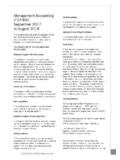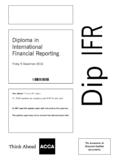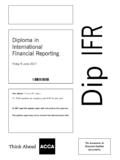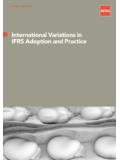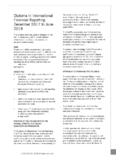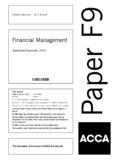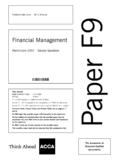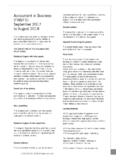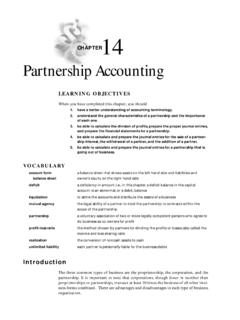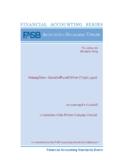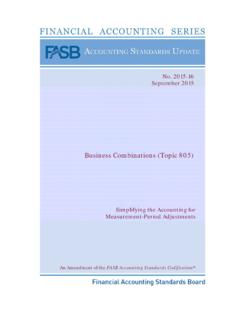Transcription of Accounting for partnerships - ACCA Global
1 RELEVANT TO FOUNDATIONS IN ACCOUNTANCY PAPER FA2 2011 ACCA Accounting for partnerships The launch of the syllabus for Foundations in Accountancy provides a good opportunity to revisit the topic of Accounting for partnerships . The syllabus for Paper FA2, Maintaining Financial Records contains an additional outcome that was not in the Syllabus for CAT Paper 3 (Section H3 Change in partnership). Also, a recurring feature of performance in CAT Paper 3 exams was that a disappointingly low number of candidates performed well on questions that examined the topic of partnerships .
2 The purpose of this article is to assist candidates to develop their understanding of the topic of Accounting for partnerships . As such, it covers all of the outcomes in Section H of the Study Guide for Paper FA2. It also provides underpinning knowledge for candidates studying Papers FFA and F3, Financial Accounting but it is not intended to comprehensively cover the Study Guides for those papers. What is a partnership? There are a number of ways in which a partnership may be defined, but there are four key elements.
3 Two or more individuals A partnership includes at least two individuals (partners). In certain jurisdictions, there may be an upper limit to the number of partners but, as that is a legal point, it is not part of the Paper FA2 syllabus. Business arrangement A partnership exists to carry on a business. Profit motive As it is a business, the partners seek to generate a profit. Unincorporated business entity A partnership is an unincorporated business entity. That means: the reporting entity (business entity) principle applies to a partnership, so for Accounting purposes, the partnership is a separate entity from the partners the partners have unlimited liability, and if the partnership is unable to pay its liabilities , the partners may be called upon to use their personal assets to clear unpaid liabilities of the partnership.
4 How is a partnership controlled? It is good practice to set out the terms agreed by the partners in a partnership agreement. While this is not mandatory, it can reduce the possibility of expensive and acrimonious disputes in the future. As a formal agreement is not mandatory, there is no definitive list of what it should contain, but Paper FA2 exams will not go beyond the following: Share of residual profit The Paper FA2 Study Guide defines this as the amount of profit available to be shared between the partners in the profit and loss sharing ratio, after all other appropriations have been made.
5 2 Accounting FOR partnerships AUGUST 2011 2011 ACCA Therefore, candidates need to be aware that there is a distinction to be made between the profit for the year (income minus expenses), which is calculated in exactly the same way as for a sole trader and residual profit (the remaining profit after profit for the year has been adjusted by the appropriations in accordance with the partnership agreement). It s worth pointing out that when a question states the profit or loss sharing ratio, that the proportions are always applied to the residual profit not the profit for the year.
6 Appropriations of profit As there is no requirement for all of the appropriations considered below to be included by a specific partnership, exam questions may only include some of them. That means that you only need to deal with the appropriations referred to in the question. Another point to remember is that the Appropriation Account is an additional Accounting statement that is required for a partnership. For a sole trader, the profit for the year is simply transferred to the credit side of the proprietor s capital account (the double entry is completed by a debit entry in the income statement, resulting in a nil balance on that statement).
7 In the case of a partnership, the income statement will still be debited, but the profit will be credited to the appropriation account, rather than the capital account. As each appropriation is dealt with, the double entry is completed through entries in both the appropriation account and the partner s current account (if current accounts are not maintained by the partnership, the entries will be made in the capital accounts). Partners salaries In some ways, the term salaries is a misleading description.
8 The salaries of employees are business expenses that are written off to the income statement, thereby reducing profit for the year. However, as partners are the owners of the business, any amounts that are paid to them under the partnership agreement are part of their share of the profit. As the amount is guaranteed, it must be dealt with through a credit entry in the partner s account (usually the current account) before the residual profit is shared. The double entry is completed by a debit entry in the Appropriation Account.
9 Interest on capital Almost always, interest on capital will be paid on partners capital balances only although the balances on the current accounts are actually part of the total capital balance, it is normal to exclude them from the value of capital on which interest is paid. Paying interest on capital is a means of rewarding partners for investing funds in the partnership as opposed to alternative investments. As such, it reduces the amount of profit available for sharing in the profit and loss sharing ratio.
10 This means that a debit entry is needed in the Appropriation Account. The double entry is completed by a credit entry in the current account of the partner to whom the salary is paid. 3 Accounting FOR partnerships AUGUST 2011 2011 ACCA Interest on drawings Charging interest on drawings is a means of discouraging partners from withdrawing excessive amounts from the business. From this, it follows that interest on drawings is a debit entry in the partners current accounts and a credit entry in the Appropriation Account.
